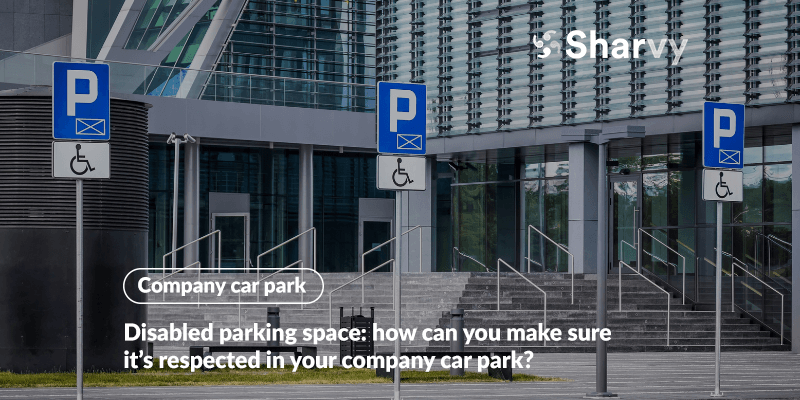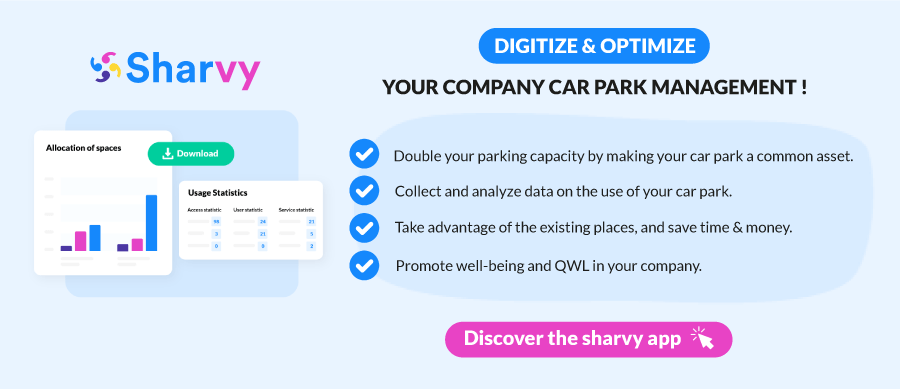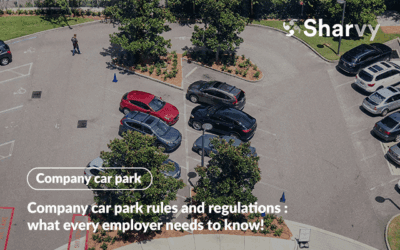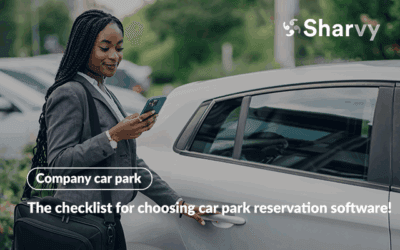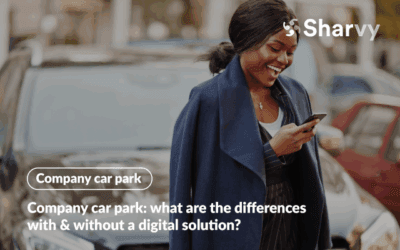Is your company car park really accessible to all your employees? How often is a disabled parking space occupied by a vehicle that isn’t entitled to it, causing frustration and incomprehension for the people concerned?
These situations are more than just an inconvenience: they reveal flaws in the management of your company car park and can put your company at odds with the law.
But over and above legal compliance, they send out the message that inclusion and compliance with the rules are not a priority, and this is felt in the day-to-day work of your teams.
So how can you ensure that your disabled parking spaces are respected and genuinely available to those who need them? Focus in this article.
What are the legal requirements for disabled parking space in companies?
Companies have specific obligations to ensure that their car parks are accessible to disabled people.
Under UK law, including the Equality Act 2010, a minimum number of disabled parking spaces must be provided. For car parks with up to 20 spaces, at least one space should be reserved for disabled users. For larger car parks, approximately 5% of spaces should be allocated for disabled drivers, ideally distributed across different areas of the car park to ensure accessibility.
Each disabled parking space must be wide enough to accommodate wheelchair users. Typically, a standard space should be at least 3.3 metres wide, or 2.3 metres wide with a 1-metre access aisle. Spaces should be located as close as possible to building entrances and reception areas, connected via a safe, step-free, and obstacle-free path.
Clear signage and floor markings are also essential. Visible signs, distinctive road markings, and where possible, pictograms and contrasting colours help ensure the spaces are recognised and properly used.
Ensuring compliance with these requirements is not just a legal obligation, it also demonstrates your company’s commitment to inclusion and accessibility.
The challenges of managing disabled parking space in company car parks.
1. Occupation of disabled parking space by unauthorised persons.
The most common abuse is, of course, the occupation of disabled parking space by people who have no right to do so. Some employees and visitors park in these spaces out of convenience or habit (unfortunately).
This abuse is all the more widespread as PRM spaces are often closest to entrances, lifts and main access points. This makes them very attractive to those looking to save time or park quickly. However, these spaces are designed to meet a vital need: guaranteeing accessibility and mobility for people with disabilities or reduced mobility.
This type of behaviour blocks access to people who really need it , leading to frustration and wasted time.
2. The lack of traceability and the difficulty of monitoring the use of PRM spaces.
Even today, companies still find it difficult to know who is actually using PRM spaces, which makes it difficult to impose penalties. This is especially true if the car park is shared by several companies.
And without traceability, it’s impossible to distinguish legitimate use from abuse.
This lack of transparency complicates the application of penalties, as well as simple reminders. The result: abuses are repeated, the rules become difficult to enforce and frustration grows among the employees concerned.
3. The impact on the company and its employees.
What if non-compliance with disabled parking space wasn’t just a parking issue ?
Each repeated abuse sends out the (implicit) message that the rules can be circumvented, and that inclusion is not really a priority. But what impact can this have on your teams?
On a day-to-day basis, this behaviour creates a climate of frustration and injustice: some employees feel wronged, others exasperated by the absence of sanctions. Gradually, this leads to internal tensions, a loss of confidence and demotivation that go far beyond simple car park management.
And in terms of image, what do visitors or employees perceive when they see these tolerated abuses? Often, they get the impression that the company is not very organised, that it does not pay much attention to its commitment to inclusion, or to the well-being of its teams.
How does the Sharvy solution help to prevent and manage abuse of disabled parking space?
1. Intelligent access control: who can really get in?
Have you ever noticed that some vehicles enter and leave the car park without being checked? That’s why, in a conventional « » car park, it’ s impossible to know whether the person occupying a PRM space is really allowed in.
Thanks to Sharvy access control application, this problem no longer exists. The barrier only opens for employees who have a valid reservation and are authorised to use the car park. Visitors and employees who are not eligible remain outside, and those who have not made a reservation simply cannot enter.
The result: abuse for convenience is reduced to a minimum, and people with reduced mobility can take advantage of a genuinely available disabled parking space, with the certainty that access control guarantees their peace of mind & safety.
2. Reservation and allocation by name: who sits where?
for how long? In Sharvy, each disabled parking space is numbered and allocated by name.
Access is linked to the employee’s badge or to the automatic number plate reader (ANPR), so that every movement can be traced.
There’s no need to chase after users or issue constant reminders: the administrator can immediately identify any non-compliant use. And for employees, there is total transparency: everyone knows that no place is reserved « in the shade » and that the system is fair.
3. Management of time slots and temporary use: there’s a place for everyone.
How do you manage deliveries, loading/unloading or one-off requirements without inconveniencing PRMs?
Sharvy lets you manage dedicated time slots and even allocate a specific space for delivery vehicles and temporary uses, with permanent access if necessary.
In this way, no-one has to fight for a space close to the entrance: PRMs always keep their priority spaces, and occasional use is organised so as not to create conflicts. The car park becomes a fluid space, where every need is anticipated.
4. Fair parking policy: a car park for everyone.
Have you ever noticed that in some car parks, spaces seem to be reserved for the same employees every day? With Sharvy, manage dedicated time slots & credit system guarantee fair rotation.
Priority is given to disabled parking space for those who need them, while other spaces are allocated equally to all employees. Parking becomes a common good, not a privilege for executives & managers.
Every user knows that they have a real chance of accessing a space, reinforcing both fairness and internal cohesion.
In conclusion
The management of company car parks goes far beyond the organisation of spaces: it reflects the company’s ability to reconcile operational efficiency with social responsibility. Controlled access and a clear allocation of spaces help to reduce conflicts, optimise the use of resources and strengthen employee confidence.
That’s why, by implementing appropriate solutions, your company can affirm its commitment to inclusive & equitable practices, while improving the day-to-day experience of your teams.
Do you have a question? Consult the following FAQ!
Are solutions such as Sharvy suitable for small businesses?
Absolutely. Even in a small car park, intelligent access control and a reservation system can optimise the use of available spaces. Every employee knows exactly where to park and when, which reduces abuse and conflicts. What’s more, the administrator gains clear & simple monitoring, without excessive complexity, and can quickly adjust the parking policy as required.
Can the Sharvy application be adapted to car parks shared between several companies?
In a multi-company environment, it’s often difficult to know who is actually using which space. Sharvy will automatically distinguish between the employees of each company, allows occupancy to be tracked in real time and ensures that each user has access to the spaces allocated to them. On this point too, it helps to limit conflicts, secure PRM access and manage space optimally for everyone.
Can we monitor the occupancy of disabled parking spaces in real time?
Yes, solutions like Sharvy allow you to see in real time which spaces (standard & PRM) are occupied, free or reserved. This enables administrators to make quick decisions & reallocate spaces if necessary. Employees also benefit from reliable information before they travel, which reduces frustration and optimises overall parking fluidity.
Want to find out more? Check out our latest articles to stay up to date!
Company car park rules and regulations: what every employer needs to know!
Discover the essential company car park rules and regulations in the UK and ensure your business stays safe, accessible, and compliant.
The checklist for choosing car park reservation software!
How do you choose car park reservation software for your business? What features should you choose? The answers are right here.
Company car park: what are the differences with & without a digital solution?
Why opt for a digital solution for your company car park? What are the benefits compared with traditional methods? Focus!
Subscribe to our newsletter!
PARKING & WORKPLACE MANAGEMENT SOLUTION
Car park management - Charging points monitoring - Desk booking - Booking by time slots
SUBSCRIBE TO THE NEWSLETTER
Receive the latest Parking & Workplace trends by email once a month.

